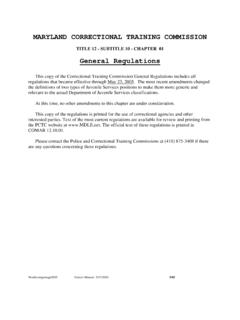Transcription of Systems Development Life Cycle (SDLC)
1 DEPARTMENT OF BUDGET & MANAGEMENT Systems Development life Cycle (SDLC) Volume 2 SDLC Phases August 2006 Systems Development life Cycle Volume 2 SDLC Phases Page 2 of 61 Table of Contents Initiation System Concept Development 6 Planning Phase .. 11 Requirements Analysis 15 Design 20 Development 29 Integration and Test 41 Implementation 45 Operations and Maintenance 50 Disposition 57 Volume 2 Initiation Phase Systems Development life Cycle Volume 2 SDLC Phases Page 3 of 61 INITIATION PHASE OBJECTIVE The Initiation Phase begins when management determines that it is necessary to enhance a business process through the application of information technology. The purposes of the Initiation Phase are to: Identify and validate an opportunity to improve business accomplishments of the organization or a deficiency related to a business need, Identify significant assumptions and constraints on solutions to that need, and Recommend the exploration of alternative concepts and methods to satisfy the need.
2 During this phase the Agency Project Sponsor designates a Project Manager who prepares a Statement of Need or Concept Proposal. IT projects may be initiated as a result of business process improvement activities, changes in business functions, advances in information technology, or may arise from external sources, such as public law, the general public or the Federal government. When an opportunity to improve business /mission accomplishments or to address a deficiency is identified, the Project Manager documents these opportunities in the Concept Proposal. TASKS AND ACTIVITIES The following activities are performed as part of the Initiation Phase. The results of these activities are captured in the Concept Proposal. For every IT project, the Agency should designate a responsible organization and assign that organization sufficient resources to execute the project.
3 Identify the Opportunity to Improve business Functions ( business Case) What is the value and purpose of the effort? Identify why a business process is necessary and what business benefits can be expected by implementing this improvement. A business scenario and context must be established in which a business problem is clearly expressed in purely business terms. Provide background information at a level of detail sufficient to familiarize senior managers to the history, issues and customer service opportunities that can be realized through improvements to business processes with the potential support of IT. This background information must not offer or predetermine any specific automated solution, tool, or product. Volume 2 Initiation Phase Systems Development life Cycle Volume 2 SDLC Phases Page 4 of Establish Project Sponsorship The Sponsor is the principle authority on matters regarding the expression of business needs, the interpretation of functional requirements language , and the mediation of issues regarding the priority, scope and domain of business requirement.
4 The Sponsor must understand what constitutes a requirement and must take ownership of the requirements and input and output. Form (or appoint) a Project Organization This activity involves the appointment of a Project Manager who carries both the responsibility and accountability for project execution . For small efforts, this may only involve assigning a project to a manager within an existing organization that already has an inherent support structure. For new, major projects, a completely new organizational element may be formed - requiring the hiring and reassignment of many technical and business specialists. To provide a management structure for the project, the project office should adapt, adopt, or create written processes and procedures for recurring project office activities.
5 These include requirements management, project tracking, contractor management, verification and validation, quality assurance, change management, and risk management. Document the Phase Efforts The results of the efforts of this phase are documented in the Concept Proposal and the Project Management Charter. Templates for these documents can be found in Volume 4 of the SDLC. Review and Approval to Proceed to the Next Phase The approval of the Concept Proposal identifies the end of the Initiation Phase. Approval should be annotated on the Concept Proposal by the Sponsor and the Agency CIO. Form Core Project Team Once approval to proceed has been given within the Agency, a core project team with participation of a Project Manager must be established in order to move on to the System Concept Development Phase and, in the case of a major IT investment, begin completing the ITPR to initiate the Investment Review process .
6 ROLES AND RESPONSIBILITIES Sponsor: The Agency Project Sponsor is the senior spokesperson for the project, and is responsible for ensuring that the needs and accomplishments within the business area are widely known and understood. The Sponsor is also responsible for ensuring that Volume 2 Initiation Phase Systems Development life Cycle Volume 2 SDLC Phases Page 5 of 61adequate financial and business process resources to address their business area needs are made available in a timely manner. Project Manager: The appointed Project Manager is charged with leading the efforts to ensure that all business aspects of the process improvement effort are identified in the Concept Proposal. This includes establishing detailed project plans and schedules.
7 DELIVERABLES, RESPONSIBILITY AND ACTION The following deliverables shall be initiated during the Initiation Phase: Concept Proposal This document describes the need or opportunity to improve business functions. It identifies where strategic goals are not being met or mission performance needs to be improved. Project Management Charter This document identifies the Sponsor and Project Manager and identifies their roles and responsibilities. ISSUES FOR CONSIDERATION In this phase, it is important to state the needs or opportunities in business terms. Avoid identifying a specific product or vendor as the solution. The Concept Proposal should not be more than 2-5 pages in length. REVIEW ACTIVITY The Initiation Phase Review shall be performed at the end of this phase and ensures that the Concept Proposal is approved before proceeding to the next phase.
8 The review ensures that the Concept Proposal is sound, does not conflict with the Enterprise Architecture and is a good investment. This is the first key decision required in the SDLC and IT Investment Management process . PRODUCTS AND APPROVALS Initiation Phase Products Approved By Concept Proposal Agency Project Sponsor Agency CIO Project Management Charter Agency Project Sponsor Agency CIO Volume 2 System Concept Development Phase Systems Development life Cycle Volume 2 SDLC Phases Page 6 of 61 SYSTEM CONCEPT Development PHASE OBJECTIVE System Concept Development begins when the Concept Proposal has been formally approved and requires study and analysis that may lead to system Development activities.
9 Following review and approval of the Concept Proposal, some form of Agency approval (tasking directive) should be issued to begin the formal studies and analysis of the need. The issuing of the tasking directive initiates the System Concept Development Phase and begins the life Cycle of an identifiable project. TASKS AND ACTIVITIES The following activities are performed as part of the System Concept Development Phase. The results of these activities are captured in the System Boundary Document (SBD) and the Risk Management Plan and their underlying institutional processes and procedures. Analyze the business Need The project team, supplemented by enterprise architecture experts, if needed, should determine the acquisition strategy by analyzing all feasible technical, business process , and commercial alternatives to meeting the business need.
10 In addition, these alternatives should then be analyzed from a life Cycle cost perspective. The results of these studies should show a range of feasible alternatives based on life Cycle cost, technical capability, operational feasibility and scheduled availability. Typically, these studies should narrow the system technical approaches to only a few potential, desirable solutions that should proceed into the subsequent life Cycle phases. Caution is needed to ensure new and/or creative design concepts are not eliminated from consideration in a Request for Proposal that is prepared. Plan the Project The project team should plan the subsequent phases to allow Development of project schedule, budget requirements, and the expected performance benefits.
















